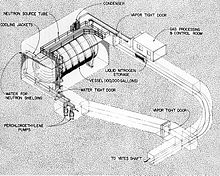Homestake experiment
The Homestake experiment is a pioneering experiment in neutrino physics at the Homestake gold mine near Rapid City in South Dakota . It was built in the 1960s under the direction of Raymond Davis Jr. and was in operation from 1970 to 1994.
Coordinates: 44 ° 21 '12 " N , 103 ° 44' 39" W.
experiment
The neutrino detector , located 1478 m underground, consisted of 615 t of tetrachlorethylene . The capture reaction is
Due to the low energy threshold of 0.814 MeV for this reaction, it was the first experiment with which one could detect and count solar neutrinos. The reaction itself cannot be detected, but the resulting argon atom is radioactive and, with a half-life of 35 days, decays back into an excited chlorine atom. In order to prove this decay, the tank was flushed every few weeks with helium as the carrier gas and the argon was collected in a cold trap.
The collected argon was purified in several steps, placed in specially designed proportional counters and examined for decay for 250 to 400 days. Because of the very low counting rate of around one event per week, special precautions had to be taken to suppress the ambient radiation. The counter tubes were therefore specially shielded and had an external detector connected to anticoincidence . Furthermore, the pulse shape of the proportional counter was evaluated to identify the low-energy argon decays.
During the entire experiment, one had to pay close attention to nuclear reactions that were not caused by the described neutrino capture. High-energy muons from cosmic rays , neutrons from the rock of the mine, alpha emitters in the building material of the tank system, radon contamination from the ambient air in the mine, as well as tritium and other impurities in tetrachlorethylene were considered as possible sources of interference . To shield it from neutron radiation, the tank was located in a basin flooded with water. The level of muon radiation was measured at different depths of the mine by generating 37 Ar in tanks with one ton of 39 K solution each . In terms of the neutrino experiment, about 0.05 argon atoms per day were generated by the cosmic radiation.
Result
The measured capture rate of 0.5 neutrinos per day was only about a third of that predicted from the standard models of the sun and elementary particle physics . That was the origin of the solar neutrino problem . In 2002 Davis was awarded the Nobel Prize in Physics for the Homestake experiment.
Web links
Individual evidence
- ↑ a b B. T. Cleveland et al: Measurement of the Solar Electron Neutrino Flux with the Homestake Chlorine Detector . In: Astrophysical Journal . 496, 1998, pp. 505-526. doi : 10.1086 / 305343 .
- ^ The Nobel Prize in Physics 2002. Nobel Foundation, accessed November 8, 2018 .


